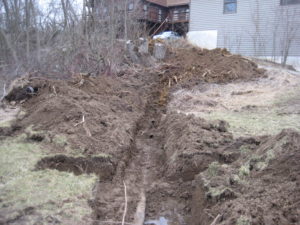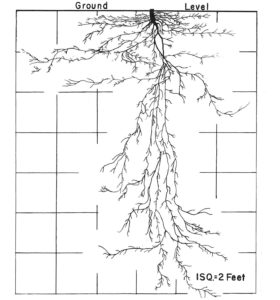Tree Roots Damage Septic Systems
Over the past half-century, I have seen several local instances where trees have gotten their roots into rural septic systems and caused the need for substantial repairs. And the literature going back nearly a century has been emphatic about keeping trees away from these systems. If you have an older system in Johnson County, replacing a tank or a leach field must be done conforming to modern building code, which can get pricey.

Trenching up to the cottonwood tree stump from the leach field.
Recently, a friend’s system stopped working and it wasn’t obvious why the tank was overflowing. But following the line from the tank toward the leach field, by opening a trench with a backhoe, lead directly beneath a large vigorously growing cottonwood tree, and then there was no doubt where the problem lie.
Ordinarily, cottonwood is a floodplain tree, an inhabitant of shallow water tables. If you make firewood from green cottonwood, it initially is very heavy, but if you dry it well, it becomes very light with little heating value, and you wonder why you went to the trouble to cut and stack it.
The other common floodplain trees also have a bad reputation regarding septic systems, especially willow, silver maple, and sycamore. But any species can avail itself of the situation if it needs to. My closest neighbors, high on a hillside, lost their entire system due to an ash tree, which ran its roots throughout the lines, creating partial clogs throughout.
So how far away is a safe distance? There is a long-standing legend that trees extend their roots out to the drip line of the branches. But I’ve paid attention to construction sites since childhood, and most assuredly this is not true. Trees are very “plastic” living beings, and as individuals adapt their growth style to their individual circumstances.
One of the best documentations of this comes from Nebraska. Late in the Great Depression, George Condra and M. B. Jenkins* took advantage of available WPA labor and had their guys dig up whole trees to study the root systems, while they documented species, age, depth to groundwater, etc. Here are two samples of the same species, illustrating this plasticity.

This 4-year-old peachleaf willow grew where the water table was 16 feet deep, and therefore sent most of its roots downward to the capillary fringe.

This 16-year-old peachleaf willow grew where the water table was only 2.5 feet down and therefore sent its roots out shallow and laterally, which keeps them in oxygenated soil and provides structural support against tipping over in wet seasons.
How do trees sense the water table or your septic field? I suppose that they are reading gradients. If your dog smells dinner more strongly to the left, his head turns left and his body follows. I think that roots similarly compare notes about which ones are picking up water and oxygen more favorably from the soil, and direct growth in that direction. We critters have two eyes, two ears, two nostrils, ets., which gives directionality to our senses. Trees have a whole 3D network of roots, which is probably fine-tuned far beyond what is available to our simple bilateral systems.
Note that the preceding paragraph is an interpretation, the door is just beginning to open regarding how trees sense and respond to their environment. When this responding is done by humans, we call it intelligence; with animals we call it instinct, and with plants we are willing to assume it is just following some path of least resistance. But ever so slowly this distinction is fading and the suspicion is growing that we are not the ultimate organism and every species has its own unique tool kit and an intelligence geared to its receptors and needs. It is rather meaningless to compare intelligence between species.
*Reference: The Nebraska tree root study was interrupted by WWII and not published by Condra and Jenkins. But in 1979, John Sprackling and Ralph Read made a selection of their data and published it as “Tree Root Systems in Eastern Nebraska.”
Tags: Lon Drake, septic systems, tree roots

